Answered step by step
Verified Expert Solution
Question
1 Approved Answer
ow Help 84% Wed 4:05 PM , s Suriabob pdf (page 1 of 18) Q Search SUNLABOB RENEWABLE ENERGY: DISTRIBUTED SOLAR POWER FOR LAOS AND
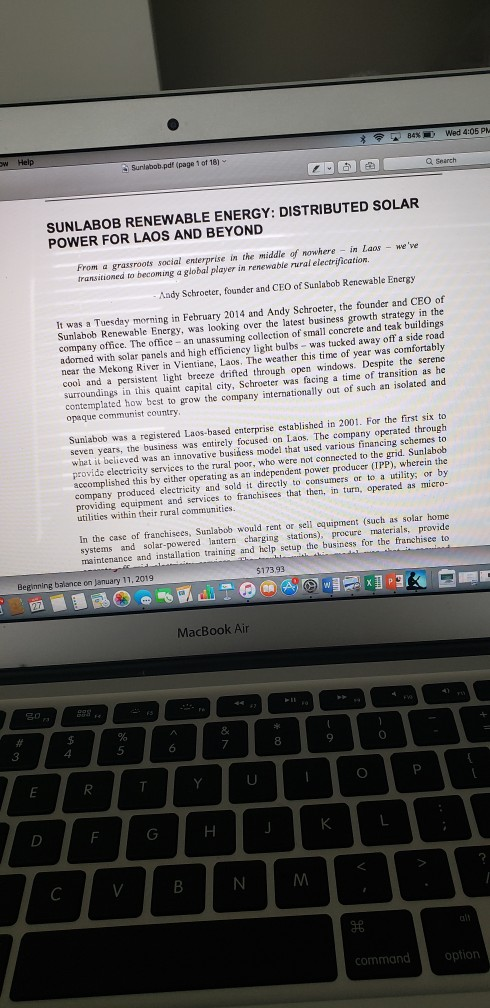
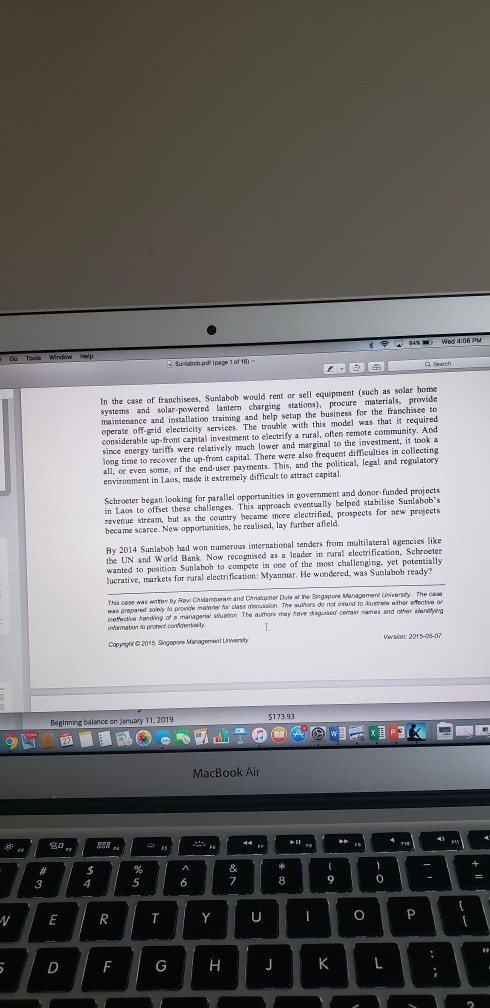
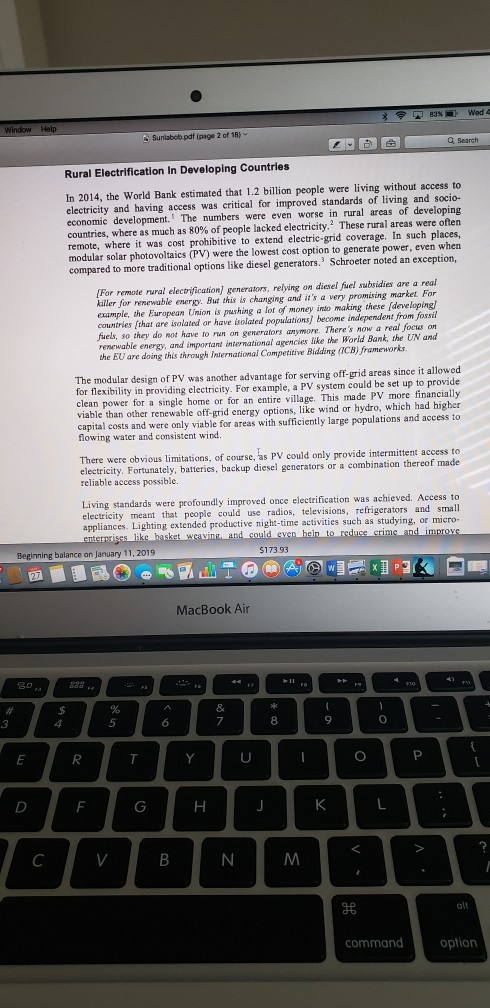

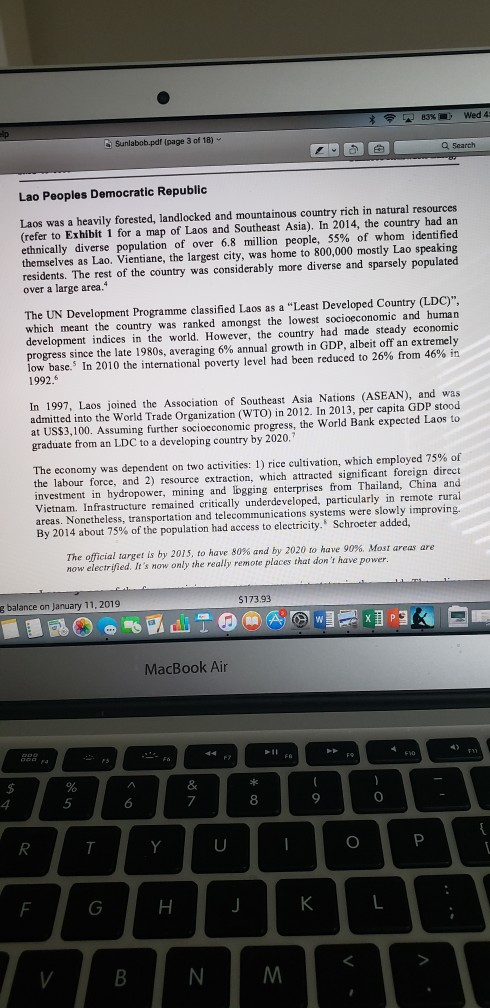
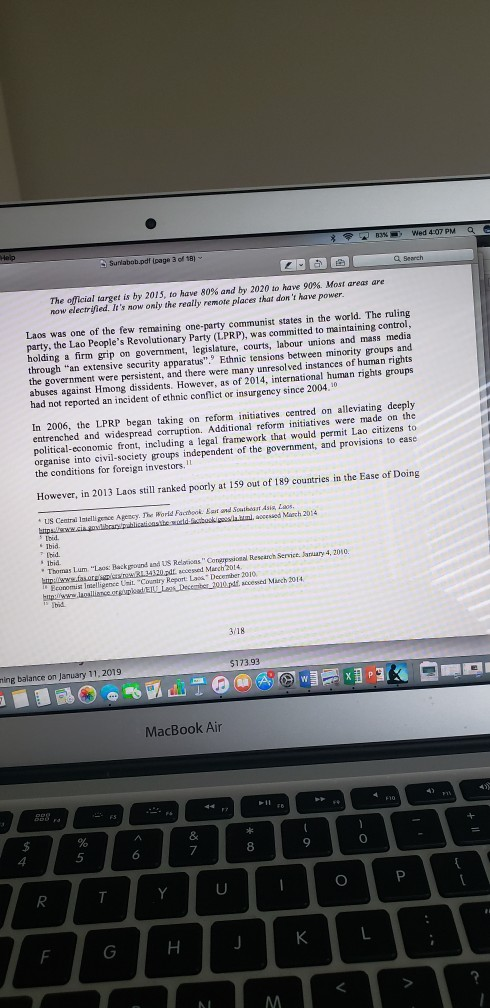
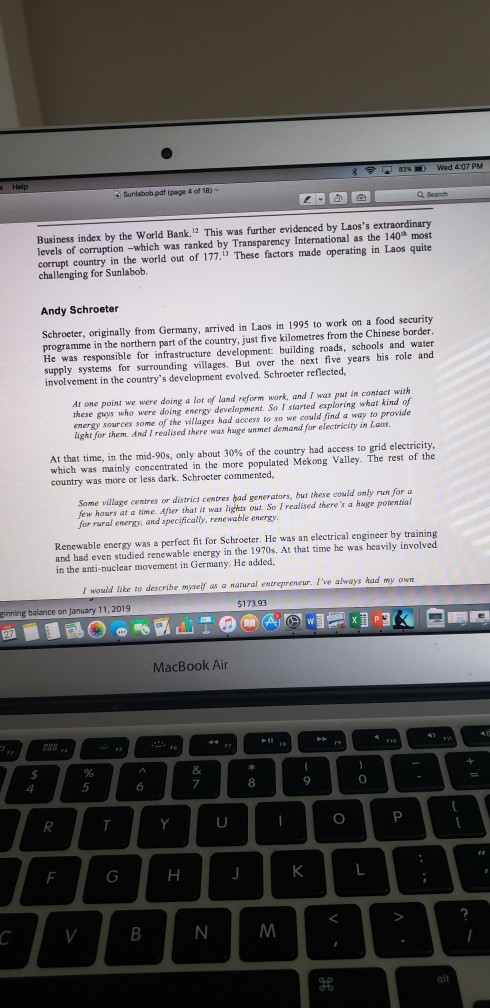
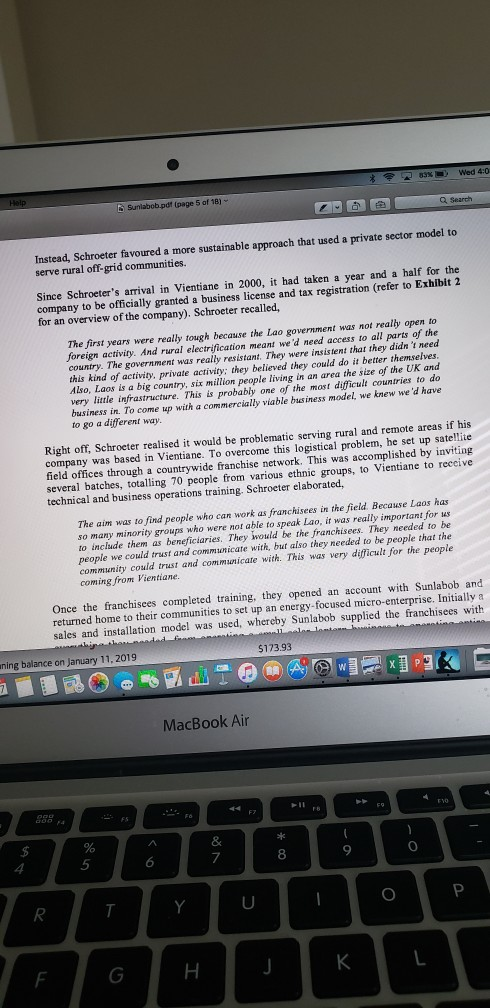
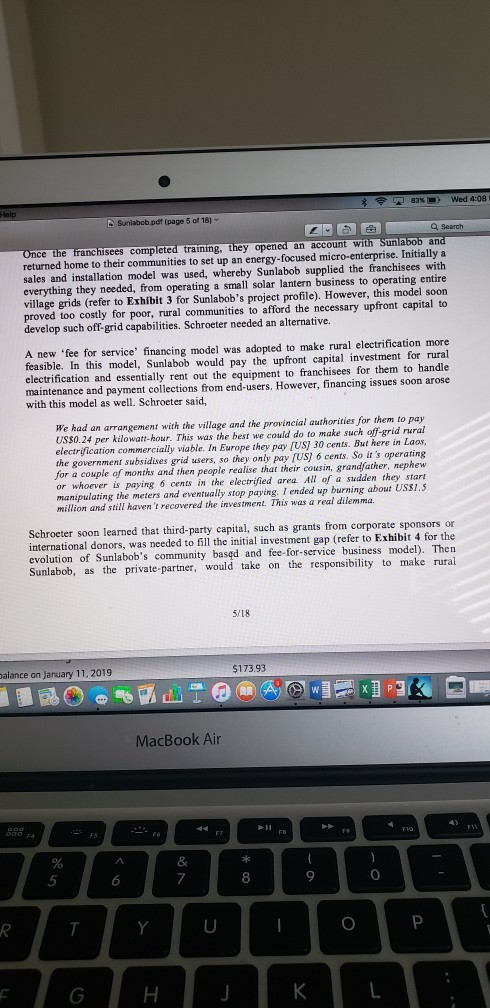


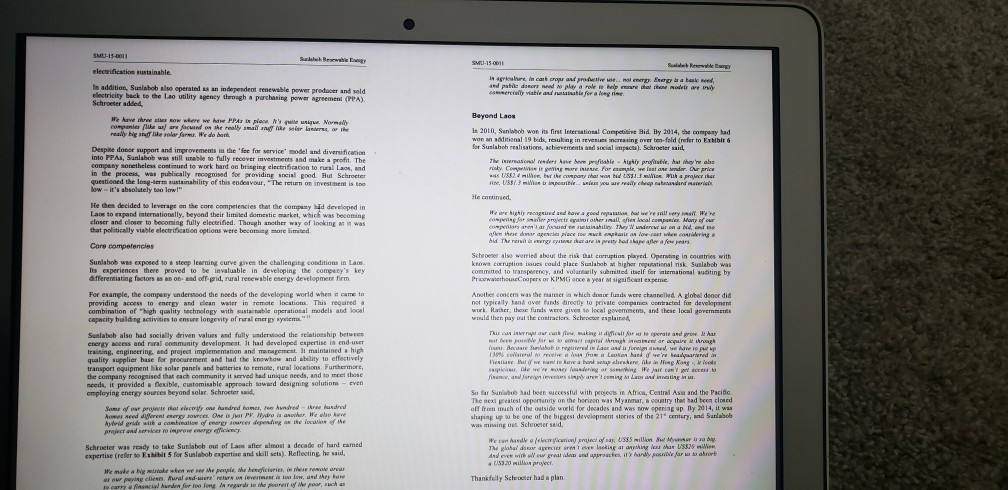
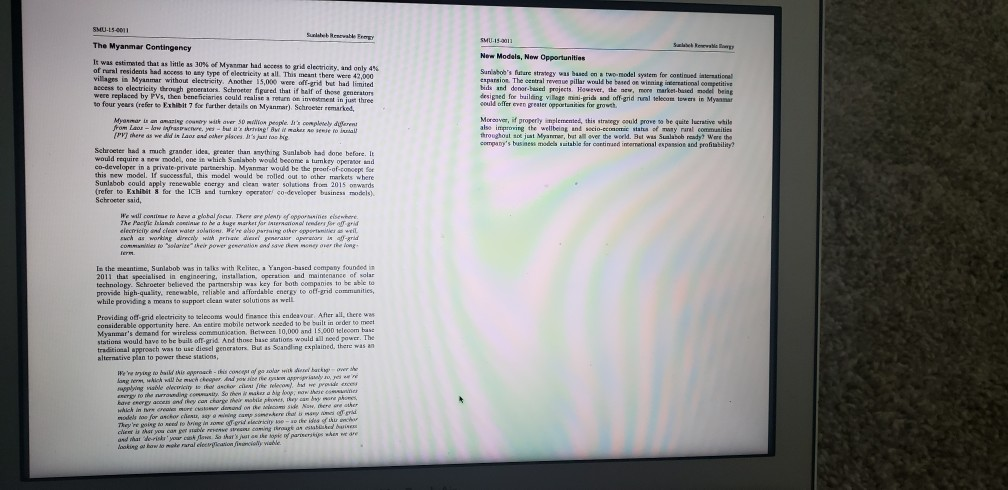
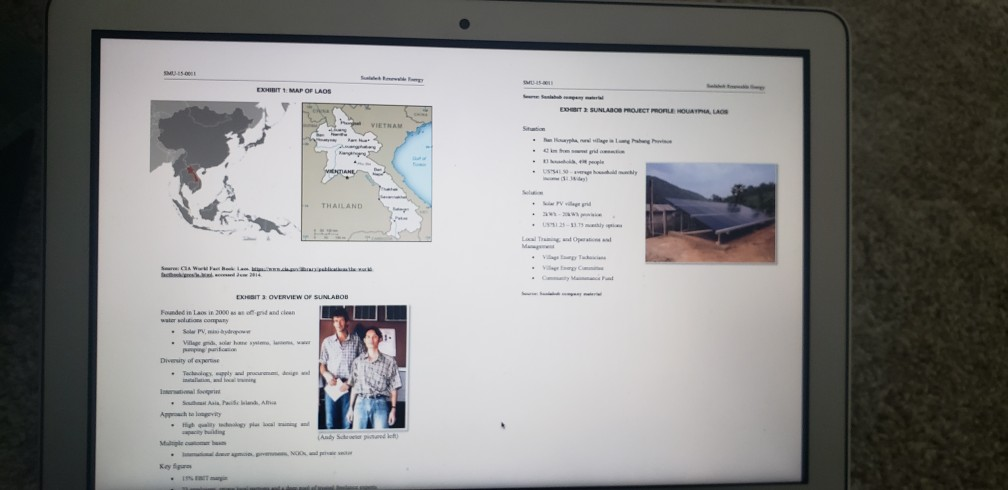

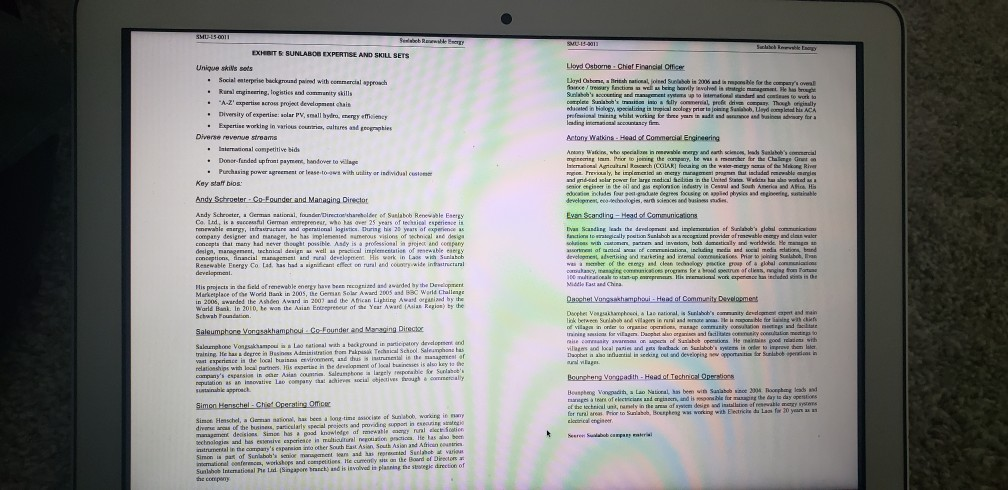
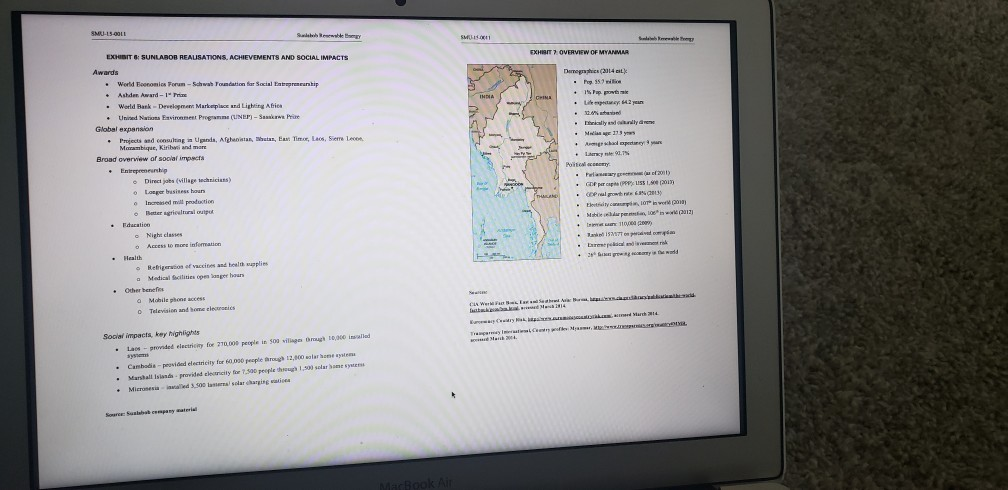
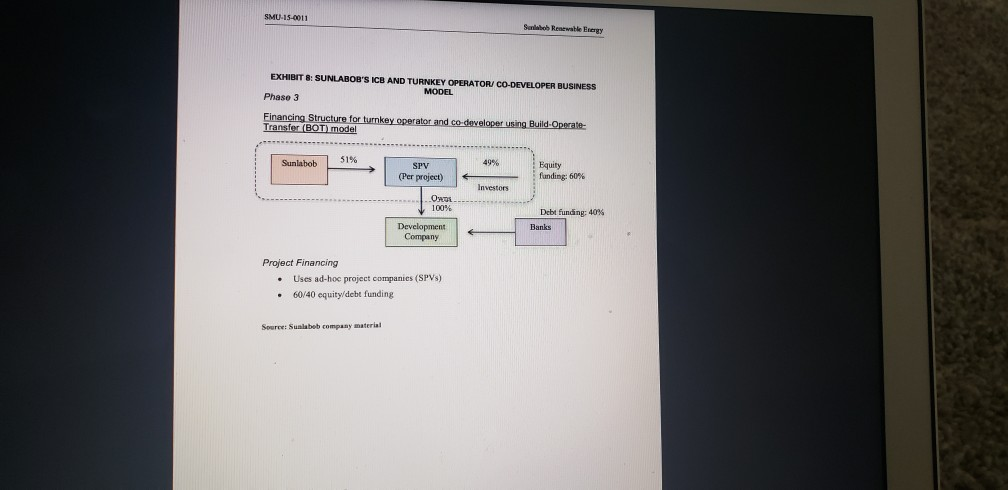

ow Help 84% Wed 4:05 PM , s Suriabob pdf (page 1 of 18) Q Search SUNLABOB RENEWABLE ENERGY: DISTRIBUTED SOLAR POWER FOR LAOS AND BEYOND From a grassroots social enterprise in the middie of nowhere - in Laas - we've ransitioned to becoming a global player in renewable rural electrification Aady Schroeter, founder and CEO of Sunlabob Renewable Energy It was a Tuesday morning in February 2014 and Andy Schroeter, the founder and CEO of Sunlabob Renewable Energy, was looking over the latest business g company office. The office- an unassuming collection of small concrete and teak buildings adorned with solar panels and high efficiency light bulbs was tucked away off a side road near the Mekong River in Vientiane, Laos. The weather this time of year was comfortably cool and a persistent light breeze drifted through open windows. Despite the serene quaint capital city, Schroeter was facing a time of transition as he contemplated how best to grow the company internationally out of such an isolated and opaque communist country ob was a registered Laos-based enterprise established in 2001. For the first six to the business was entirely focused on Laos. The company operated through ed was an innovative business model that used various financing schemes to seven years, provide electricity serviees to the rural poor, who were not connected to the grid. Sunlabob accomplished this by either operating as an independent power producer (IPP), wherein the company produced electricity and sold it directly to consumers or to a providing equipment and services to franchisees that then, in turn, operated as micro- utilities within their rural communities utility; or by in the case of franchisees, Sunlabob would rent or sell squipment (such as solar home systems and solar-powered lantern charging stations), procure materials, provide and installation training and help setup the business for the franchisee to Beginning balance on January 11, 2019 5173,93 MacBook Air command option Suniabob pd ipage 1 af 18) In the case of franchisees, Sunlabob would rent or sell equipment (such as solar home systems and solar-powered lanterm charging stations), procure materials, provide maintenance and installation training and help setup the business for the franchisee to operate off-grid electricity services. The trouble with this model was that it required considerable up-front capital investment to electrify a rural, often remote community. And since energy tariffs were relatively mach lower and marginal to the investment, it took a long time to recover the up-froat capital. There were also frequent difficulties in collecting all, or even some, of the end-user payments. This, and the political, legal and regulatory environment in Laos, made it extremely difficuls to attract capital Schroeter began looking for parallel apportunities in government and donor-funded projects in Laos to offset these challenges. This approach eventualy helped stabilise Sunlabob's reveoue stream, but as the country became more electrified, prospects for new projects became scarce. New apportunities, he realised, lay further afleld. By 2014 Sunlabob had won numerous international tenders from multilateral agencies like tbe UN and World Bank. Now recognised as a leader in rural electrification, Schroeter wanted to position Sunlabob to compere in one of the most challenging, yet potentialy ucrative, markets far rural electrification: Myanmar, He wondered, was Sunlabob ready? This case was wntee by Rew Chs and Christigner Dyls st he Singspone Managemant Uivesty The cs anding of s managerial siuaon authors may tare daguised certain names and other cndying Copyight 2015 Singepone Managerent Lnversty vwsion: 2015-05-07 Beginning balance on Jaruary 11, 2019 5173 93 MacBook Air 9 s 83 Wed4 Sunlabob.pdf (page 2 of 18) Q Search Rural Electrification In Developing Countries In 2014, the World Bank estimated that 1.2 billion people were living without access to electricity and having access was critical for improved standards of living and socio- economic development. The numbers were even worse in rural areas of developing countries where as much as 80% of people lacked electricity 2 These rural areas were often remote, where it was cost prohibitive to extend electric-grid coverage. In such places, modular solar photovoltaics (PV) were the lowest cost option to generate power, even when compared to more traditional options like diesel generators. Schroeter noted an exception, For remote rural electrification] generators, relying on diesel fuel subsidies are a real countries [that are isolated or have isolated populations] become independent from fossil renewable energy, and importand international agencies like the World Bank, the UN and killer for renewable energy: But this is changing and its a very promising market. For example, the European Union is pushing a lot of money into making these [developing fuels, so they do not have to un an generators anymove. There s now a real focus on the EU are doing this through International Competitive Bidding (ICB) frameworks The modular design of PV was another advantage for serving off-grid areas since it allowed for flexibility in providing electricity. For example, a PV system could be set up to provide clean power for a single home or for an entire village. This made PV more financially viable than other renewable off-grid energy options, like wind or hydro, which had higher capital costs and were only viable for areas with sufficiently large populations and access to flowing water and consistent wind There were obvious limitations, of course, as PV could only provide intermittent access to electricity. Fortunately, batteries, backup diesel generators or a combination thereof made reliable access possible. Living standards were profoundly improved once electrification was achieved. Access to appliances. Lighting extended productive night-time activities such as studying, or micro- electricity meant that people could use radios Beginning balance on January 11, 2019 $173.93 MacBook Air 8 0 command option 83% ( wed 4:06 P Sunlabob.pdt (page 2 of 18) Search appliances. Lighting extended productive night-time activities such as studying, or micro- enterprises like basket weaving, and could even help to reduce crime and improve healthcare. The socio-economic opportunities delivered by electrification were seemingly endless, though energy access was only one part of the development equation. Evan Scandling, head of communications at Sunlabob, said, It's not just energo provision, that's just one piece of the development puzle. In an ideal sinuation you 're coming in with other partners who are adding the capacity bwilding piece. ike that; bua those non-energy pieces when comes It can be anything, like teaching new skills, providing new materials, like books something yom hing ike teaching newi kr and we re tryig to fb r upon to provider. An energy-focused company like Sunlabob cannot be relied upon to also solve the puzzie. That's beyond our scope and expertise. But has to be holistic that's why we work with partners on these projects. And ir comes to these tenders we hid on, they 're almost ahways part of some larger whether it is, for example electriiying vocarional training centers or boosting to irnfarmation and telecommunications infrastructure at a customs c The World Bk. "Energy- The Facts 62-tesicPK 411420.00 l, ocessed March 2014 Finnced orporation-selling Solar: Lessons From More thas. Decade of FC. Espanincs. me ta ca 2007, P8. geiingsoT WC 1319577385742 accessed March 2014. 2/18 ning balance on January 11, 2019 $173.93 MacBook Air 6 8 0 Sunlabob.pdf (page 3 of 18) Q Search Lao Peoples Democratic Republic Laos was a heavily forested, landlocked and mountainous country rich in natural resources (refer to Exhibit 1 for a map of Laos and Southeast Asia). In 2014, the country had an ethnically diverse population of over 6.8 million people, 55% of whom, identified themselves as Lao. Vientiane, the largest city, was home to 800,000 mostly Lao speaking residents. The rest of the country was considerably more diverse and sparsely populated over a large area The UN Development Programme classified Laos as a "Least Developed Country (LDC)" which meant the country was ranked amongst the lowest socioeconomic and human development indices in the world. However, the country had made steady economic progress since the late 1980s, averaging 6% annual growth in GDP, albeit off an extremely low base? In 2010 the international poverty level had been reduced to 26% from 46% in 1992.5 In 1997, Laos joined the Association of Southeast Asia Nations (ASEAN), and was admitted into the World Trade Organization (WTO) in 2012. In 2013, per capita GDP stood at US$3,100. Assuming further socioeconomic progress, the World Bank expected Laos to graduate from an LDC to a developing country by 2020. The economy was dependent on two activities: 1) rice cultivation, which employed 75% of the labour force, and 2) resource extraction, which attracted significant foreign direct investment in hydropower, mining and lbgging enterprises from Thailand, China and Vietnam. Infrastructure remained critically underdeveloped, particularly in remote rural areas. Nonetheless, transportation and telecommunications systems were slowly improving. By 2014 about 75% of the population had access to electricity. Schroeter added, The official target is by 2015, to have 80% and by 2020 to have 900% Most areas are now electrified. It's now only the really remote places that don't have power g balance on January 11, 2019 5173.93 MacBook Air 8 0 B3% ., Wed 407 PM Sunlabob.pdf lpage 3 of 18 a Search The oficial target is by 2015, to have 80% and by 2020 to have 90%. Most areas are now electrified. It's now only the really remote places that don't have power. Laos was one of the few remaining one-party communist states in the world. The ruling party, the Lao People's Revolutionary Party (LPRP), was committed to maintaining holding a firm grip on government, legislature, courts, labour umions and mass media through "an extensive security apparatus"9 Ethnic tensions between minority groups and the government were persistent, and there were many unresolved instances of human righ abuses against Hmong dissidents. However, as of 2014, international human rights groups had not reported an incident of ethnic conflict or insurgency since 2004 In 2006, the LPRP began taking on reform initiatives centred on alleviating deeply entrenched and widespread corruption. Additional reform initiatives were made on t political-economic front, including a legal framework that would permit Lao eitizens to he into civil-society groups independent of the government, and provisions to ease the conditions for foreign investors However, in 2013 Laos stll ranked poorly at 159 out of 189 countries in the Ease of Doing US Ceatral 1ntelligence Agescy. The World Facnbook. Eait and Soutbeast Asis, Los ocessed Miech 2014 Ibid Ibid Thomas Lum "Las:Backggound and US Relatisns Ecuionus Intelligence UniLCountry Report Laos. December 2010 Research Serviet. Janary 4, 2010. enewRi34320 accessed March 2014 5173 93 ing balance on January 11, 2019 MacBook Air B88 8 5 8 9 0 83Wed 4:07 PM Business index by the World Bank. This was further evidenced by Laos's extraordinary levels of corruption -which was ranked by Transparency International as the 140 most corrupt country in the world out of 177.1 These factors made operating in Laos quite challenging for Sunlabob Andy Schroeter Schroeter, originally from Germany, arrived in Laos in 1995 to work on a food security programme in the northern part of the country, just five kilometres from the Chinese border He was responsible for infrastructure development: building roads, schools and water supply systems for surrounding villages. But over the next five years his role and involvement in the country's development evolved. Schroeter reflected these guys who were doing energy development. So I started exploring what kind of energy sources some of the illages had access to so we could find a way to provide ight for them. And I realised there was hage unmet demand far electricity in Laos At that time, in the mid-90s, only about 30% of the country had access to grid electricity which was mainly concentrated in the more populated Mekong Valley. The rest of the country was more or less dark. Schroeter commented Some village centres or district cemtres had generators, but these could only run for a jew hours at a time. After thar it was lights ou So I realised there's a huge potential for rural energy, and specifically, renewable energy Renewable energy was a perfect fit for Schroeter. He was an electrical engineer by training and had even studied renewable energy in the 1970s. At that time he was heavily involved in the anti-nuclear movement in Germany. He added, I wouid like to describe myself as a natural en I've always had my own inning balance on January 11, 2019 $173.93 MacBook Air 8 Sunlabob.pdt (page 5 of 18) Instead, Schroeter favoured a more sustainable approach that used a private sector model to serve rural off-grid communities. Since Schroeter's arival in Vientiane in 2000, it had taken a year and a half for the Since Schroeter' company to be officially granted a business license and tax registration (refer to Exhibit 2 for an overview of the company). Schroeter recalled, The first years were really tough because the Lao foreign activity. And rural electrification government was not really open to meant we'd need access to all parts of the country. The government was really resistant. They were insistent that they didn t need this kind of activity, private activity: they believed they could do it better themselves Also, Laos very little infr business in. is a big country, six million people living in an area the size of the UK and astructure. This is probably one of the most difficult countries to do To come up with a commercially viable business model, we knew we 'd have to go a different way Right off, Schroeter realised it would be problematie serving rural and remote areas if his pany was based in Vientiane. To overcome this logistical problem, he set up satellie field offices through a countrywide franchise network. This was accomplished by inviting several batches, totalling 70 technical and business operations training. Schroeter elaborated, people from various ethnic groups, to Vientiane to reccive The aim was to find people who can work as franchisees in the field Because Laos has who were not able to speak Lao, it was really important for us y minority groups to include them as beneficiaries. They iwould be the franchisees. They needed to be people we could trust and communicate with, but also they needed to be people that the munity could trust and communicate with. This was very difficult for the people coming from Vientiane. Once the franchisees completed training, they opened an account with Sunlabob and returned home to their communities to set up an energy-focused micro-enterprise. Initially a sales and installation model was used, whereby Sunlabob supplied the franchisees with ning balance on January 11,2019 $173.93 MacBook Air 8 9 0 83%-) Wed 4:08 | Sunlabob.pot (page 5 of 18) Q Search sees completed training, they an account with Suniabob a returned home to their communities to set up an energy-focused micro-enterprise. Initially a sales and installation model was used, whereby Sunlabob supplied the franchisees with everything they needed, from operating a small solar lantern business to operating entire village grids (refer to Exhibit 3 for Sunlabob's project profile). However, this model soon proved too costly for poor, rural communities to afford the necessary upfront capital to develop such off-grid capabilities. Schroeter needed an alternative. A new 'fee for service' financing model was adopted to make rural electrification more feasible. In this model, Sunlabob would pay the upfront capital investment for rural electrification and essentially rent out the equipment to franchisees for them to handle maintenance and payment collections from end-users. However, financing issues soon arose with this model as well. Schroeter said, We had an arrangement with the village and the provincial authorities for them to pay $0.24 per kilowatt-hour. This was the best we could do to make such off-grid rural electrification commercially viable. In Europe they pay [US) 30 cents. But here in Laos the government subsidises grid users, so they only pay [US 6 cents. So it's operating for a couple of months and then people realise that their cousin, grandfather, nephew or whoever is paying 6 cents in the electrified area All of a sudden they start manipulating the meters and eventually stop paying. I ended up burning about USS!..s illion and still haven't recovered the investment. This was a real dilemma. Schroeter soon learned that third- party capital, such as grants from corporate sponsors or international donors, was needed to fill the initial investment gap (refer to Exhibit 4 for the evolution of Sunlabob's community based and fee-for-service business model). Then Sunlabob, as the private-partner, would take on the responsibility to make rural 5/18 palance on January 11, 2019 173.93 MacBook Air 8 0 83%-E, Wed 4:06 PM Sunlabob pdf ( page 6 of 18) Q Search SMU-15-0011 Sunlabob Renewable Energy electrification sustainable. In addition, Sunlabob also operated as an independent renewable power producer and sold electricity back to the Lao utility agency through a purchasing power agreement (PPA) Schroeter added, We have three sites now where we have PPAs in place. It's quite unique Normaly companies flike usJ are focused on the really small suff like solar lanterns, or the realy big stuff like solar farms. We do both Despite donor support and improvements in the fee for service model and diversification into PPAs, Sunlabob was still unable to fully recover investments and make a profit. The company nonetheless continued to work hard on bringing electrification to rural Laos, and in the process, was publically recognised for providing social good. But Schroeter questioned the long-term sustainability of this endeavour, "The return on investment is too low-it's absolutely too low!" low oe ad ble to He then decided to leverage on the core competencies that the company had developed in Laos to expand internationally, beyond their limited domestic market, which was beconing closer and closer to becoming fully electrified. Though another way of looking at it was that politically viable electrification options were becoming more limited Core competencies Sunlabob was exposed to a steep learning curve given the challenging conditions in Laos. Its experiences there proved to be invalusble in developing the company's key differentiating factors as an on- and off-grid, rural renewahle energy development firm. For example, the company understood the needs of the developing world when it came to providing access to energy and clean water in remote locations. This required a Beginning balance on January 11, 2019 5173.93 MacBook Air commandoption Sunlabob.pdf (page 6 of 18) For example, the company understood the needs of the developing world when it came to providing access to energy and clean water in remote locations. This requireda capacity building activities to ensure longe vity of rural energy systems."1" Sunlabob also had socially driven values and fully understood the relationship between energy access and rural community development. It had developed expertise in end-user training, engineering, and project implementation and management. It maintained a high quality supplier base for procurement and had the knowhow and ability to effectively transport equipment like solar panels and batteries to remote, rural locations. Furthermore, the company recognised that each community it served had unique needs, and to meet those needs, it provided a flexible, customisable approach toward designing solutions even employing energy sources beyond solar. Schroeter said, Some of our projects that electrify one hundred homes, rwo hundred three hundred hybrid grids with a combination of energy sources depending on the location of the project and services to improve enegy efficiency. Schroeter was ready to take Sunlabob out of Laos after almost a decade of hard earned expertise (refer to Exhibit 5 for Sunlabob expertise and skill sets). Reflecting, he said, the beneficiarles, in these remote areas on investment is too low, and they have We make a big mistake when we see the as our paying clients. Rural end-users to carry a financial burden for too long. In regards to the poorest of the poor, such as much of the population in rural Laos, they're oftentimes better off making investments Sunlabob Renewable Energy Entertal document 5173.93 hing balance on January 11, 2019 MacBook Air alt MU-15-00nn te addition, Suslabob also operated as an independeot renewable power producer and sold electricity back to the Lao utility ageney through a parchasing power agreement (PPA). Schroeter added Bayond Laos companies flike ay are focuaed on she really amal a realy big andf he solar Jarmu. We do botk ke soltr anrs, or t the l: 2010, Suniahob won ns first Intersational Competitive Bid. By 1014, the company had won an additional 19 bids, resuking in revesues increasing over ten-fold (refer to Exhlbit 6 fer Sunlabob realisstions, achievements and social impacs). S Schroeter said Despite dosor support and improvements in the 'See for service model and diversification into PPAs, Sunlabob was still urable to fully recover investments and make a profit. The company sonetheless costizued to work hard on bringing electrification to rural Laos, and in the process, was publically recognised foe providing social good Bui Schrocte questioned the long-Jerm sustainability of this eodeavour, The return on investment is too ow- it's absolutely too lowl" as US$2 4 "iNen, bvr the compaty that van bid LS$1.fmiliae.inih 4 prgece 64r He cortinued. He thes decided to leverage on the core competencies that the company Hd developed in Laos to expand internationally, beyoad their limited domestic market, which was becoming closer and closer to beconing fully electrified Though another way of looking ar in was that politically able electrification options were becomag more limated /km these dnar agencia piace roo suct ampean, a.or-aet idee ea.ridern# * Core compefencies Sunlabob was exposed to a steep leerning curve gives the challengitg conditions in Laos Irs experiences there proved to be invaluable in developing the compary's key fferentiating factors as an on end off-grid, ural renewable esergy developmens firm Schroener also worried about the tisk tat eoeruption played Opersting in countries with krowa coeruptios isues could place Sunlabob at higher reguratiooal risk Sunlabob was committed to trarsperency, and volatearily submitted itvelf for atemational auditing by PricewaterhouseCoopers or KPMG ence a year at sigaificant expense For example, the company understood the needs of the developing world when in camc to providing access to energy and clean water in remote locations. This requireda combination of "high quality technology with sustainable operational models and local capacity building activities to ensure longevity of rural ener gy systems Another concers was the nanser in which docr funds were channeled A globel deoor did not typicaly hand over Furds direatly to peivate companicx contracted far davelapment work Rather, these funds were given so local govemnems, and these local ovemments would then pay oat the costractor Scheor esplainod, Sunlabeb also had socially driven values and fully understood the rclationship betwree energy necess and rural community development It had develaped expertise in end-user quality supplier base for procuremem and had the knowhou and sbility to effectively transport equipment ke solar pancls and betteries to remone, rural locations Furthermore, the company recopnised that cach community it served had unique needs, and so meet t needs, it provided a fnexible, customisable approach toward designing solutiors even employing energy sources beyond solar. Schrocter said, So far Sunabob had been saccessful with projeots in Africa, Ceatral Asia and the Pacidao The nexi greatest opperunity on the horieon was Myanmar, a couatry thes had been closed off froen mach of the outside woeld for decades and was now spering up ly 2014, it was shaping up o be one of the biggest development stories of the 21 century, and Sunlabob was mising ost Schroener seid hybrid griuds wile a canbinatise of mngy sources depending as the focation of se praject and services to iprove enngy licency Schroeter was ready to take Sunlabob out of Laos after almost a decade of hard earmed expertise (refer to Eshibit 5 for Sunlabob expertise and skill sets). Reflecting he said, And ece wih sW our great isau snd approuthes is hany sossive ar u to ahrort C5320 milion project We make a big mintake when we see she peopls, the benciaries, is reue rewoe arear to carry a Rasacial burden for too fong ia regards to the pooresr of he poar, such as Thankfully Scheoeter hadaplan SMU-15-0011 Surlsbeb Renevable Enogy SMU.15-2011 The Myanmar Contingency New Modeis, New Opportunities It was estim ted that as little as 30% of Myanmar ha of rural residents had access to villages is Myanma access to electrieity through generators. Schroeter were replaced by PVs, then beneficiaries could realise a retarn on in to four yewes (refer to Exhibit 7 for farther details on Myanmar). Schreeser remarked d access to grid electricity, and only 4% Sunsbob's fiutare s uny hpe of elecricity at all. This meant there wert 42,000 S,000 were off-grid but had limited traeay was based on a two model syatem for continued intersational dooor-besed projects. However, the new, more market-bated model beiag r without electricity. Another l esparsion. The eentral reveaue pillar would be besed oe wirning intereational co bids and figured that if half of those generator designed foe bailding village miai-rids and off-grid rural telecos lowers in Myaamar oould offer even greater oppertunitie for groweh. investment in just three Myanmar is on anazing coumry witk aver 50 miiion people. It'z conpltely d Pv there as we did it laor and osker pisces. It's jant tos bhg Moroaver, if properly inplemented, this stracegy could prove o be quite luerative while alse improwing the wellbeing and secio-eccanomc status of way rarel communities throughoat sot just Myanmr, but all over tbe woeld. Bet was Sualabob ready? Were th company's business models suitable for contimaed incemational expansion and profiuility Schroeter had a much grander ides, greater than anything Sunlabob had done before. It would require a new model, one it which Sunlabeb would become tumkty operancr n eo-developer in a private private partsership. Myanmar would be the preof-of-concep S this new model. If suocessful, this model would be rolled out so other markets where Sunlabob could apply renewable energy and clean waner solutices from 2015 onwards refer to Exhibit 8 for the ICH and tunkey operator so-developer basiness models) Schroeter said, We will contieue to hewe a plabal facur, There ore plenty efpporsines eisewhere. electricioy and tieen waler solation. We're aso paruing other opporismie as well evch as working direcny witsh prhate det gearaar apraar-grid communities ssolarize-heir power ge-eroso" ens save iken wsncy overee long. In the meantime, Sunlabob was in talks with Kelitre, a Yangon-based eempaty lounded in 2011 that specialised in engineering, installation, operation snd maintenance of technology. Schroeter believed the partsership was key fur both companies to be abie to provide high-qualaty, resewable, reliable and affurdable energy to off-grid communities, while provding means to support a solar clcan water solutions as well Providing ot-grid electricity so selecoms would finance this endeavour. After all, here was considerable opportunity here. An eetze mobile network reeded to be built in oeder to meat Myanmar's demand for wircless communication, Beiween 10,000 and 1S,000 teleoom base stations would have to be bails off-grid And those hase stations would all need ower. The tradational approach was to use diesel generatorx. But as Scandling explained, there was an alternative plan to power theve stations charge ther mabile phones, y cae bay mone phones laoking as how do moke raral cheerfhicasion inancialtly wable EXOHIBIT 1 MAP OF LADS THAILAND Founded ine Laos in 2000 of gnd and clean Diversity of exprse EXHIBIT & EVOLUTION OF EXHIBIT 4 EVOLUTION OF SUNLABCR COMMUNITY BASED A AND FEE-FOR SERVICE BIUSINESS MODEL ICONT Phase 2 Heng Keng besed Dosor Trnat Fand New Fininarg 02 Tagsts Lessons leamed Laveraging igh quulsy technolngy and devleing srng lacal echnical ski * Concs and models ane SMU-15-0011 Sanlwbob Renewable Energy EXHIBIT 8: SUNLABOB'S ICB AND TURNKEY OPERATOR/ CO-DEVELOPER BUSINESS MODEL Phase 3 51% Sunlabob 49% SPV (Per project) Equity : funding: 60% Investors 100% Debt funding: 40% Companyl Project Financing Uses ad-hoc project companies (SPVS) 60/40 equity/debt funding Source: Sualabeb company material 1. What are social enterprises and what problems do they face? 2. What should Sunlabob's business plan look like and how should it think through its business plan? What problems did Sunlabob face in building a sustainable business? 3. What measuring tools are useful in measuring social impact? How well does Sunlabob meet its social goals? 4. Why do social enterprises such as Sunlabob find it harder to tap into commercial financing compared to normal for-profit companies? What funding options do they have? 5. What are the features of S unlabob's new market-based business model in Myanmar? What challenges does it face in implementing the new model and how can it address those challenges? Sunlabob Case.pdf Permalink Enerzorb Case and Questions Rolls Royce Case and Questions ow Help 84% Wed 4:05 PM , s Suriabob pdf (page 1 of 18) Q Search SUNLABOB RENEWABLE ENERGY: DISTRIBUTED SOLAR POWER FOR LAOS AND BEYOND From a grassroots social enterprise in the middie of nowhere - in Laas - we've ransitioned to becoming a global player in renewable rural electrification Aady Schroeter, founder and CEO of Sunlabob Renewable Energy It was a Tuesday morning in February 2014 and Andy Schroeter, the founder and CEO of Sunlabob Renewable Energy, was looking over the latest business g company office. The office- an unassuming collection of small concrete and teak buildings adorned with solar panels and high efficiency light bulbs was tucked away off a side road near the Mekong River in Vientiane, Laos. The weather this time of year was comfortably cool and a persistent light breeze drifted through open windows. Despite the serene quaint capital city, Schroeter was facing a time of transition as he contemplated how best to grow the company internationally out of such an isolated and opaque communist country ob was a registered Laos-based enterprise established in 2001. For the first six to the business was entirely focused on Laos. The company operated through ed was an innovative business model that used various financing schemes to seven years, provide electricity serviees to the rural poor, who were not connected to the grid. Sunlabob accomplished this by either operating as an independent power producer (IPP), wherein the company produced electricity and sold it directly to consumers or to a providing equipment and services to franchisees that then, in turn, operated as micro- utilities within their rural communities utility; or by in the case of franchisees, Sunlabob would rent or sell squipment (such as solar home systems and solar-powered lantern charging stations), procure materials, provide and installation training and help setup the business for the franchisee to Beginning balance on January 11, 2019 5173,93 MacBook Air command option Suniabob pd ipage 1 af 18) In the case of franchisees, Sunlabob would rent or sell equipment (such as solar home systems and solar-powered lanterm charging stations), procure materials, provide maintenance and installation training and help setup the business for the franchisee to operate off-grid electricity services. The trouble with this model was that it required considerable up-front capital investment to electrify a rural, often remote community. And since energy tariffs were relatively mach lower and marginal to the investment, it took a long time to recover the up-froat capital. There were also frequent difficulties in collecting all, or even some, of the end-user payments. This, and the political, legal and regulatory environment in Laos, made it extremely difficuls to attract capital Schroeter began looking for parallel apportunities in government and donor-funded projects in Laos to offset these challenges. This approach eventualy helped stabilise Sunlabob's reveoue stream, but as the country became more electrified, prospects for new projects became scarce. New apportunities, he realised, lay further afleld. By 2014 Sunlabob had won numerous international tenders from multilateral agencies like tbe UN and World Bank. Now recognised as a leader in rural electrification, Schroeter wanted to position Sunlabob to compere in one of the most challenging, yet potentialy ucrative, markets far rural electrification: Myanmar, He wondered, was Sunlabob ready? This case was wntee by Rew Chs and Christigner Dyls st he Singspone Managemant Uivesty The cs anding of s managerial siuaon authors may tare daguised certain names and other cndying Copyight 2015 Singepone Managerent Lnversty vwsion: 2015-05-07 Beginning balance on Jaruary 11, 2019 5173 93 MacBook Air 9 s 83 Wed4 Sunlabob.pdf (page 2 of 18) Q Search Rural Electrification In Developing Countries In 2014, the World Bank estimated that 1.2 billion people were living without access to electricity and having access was critical for improved standards of living and socio- economic development. The numbers were even worse in rural areas of developing countries where as much as 80% of people lacked electricity 2 These rural areas were often remote, where it was cost prohibitive to extend electric-grid coverage. In such places, modular solar photovoltaics (PV) were the lowest cost option to generate power, even when compared to more traditional options like diesel generators. Schroeter noted an exception, For remote rural electrification] generators, relying on diesel fuel subsidies are a real countries [that are isolated or have isolated populations] become independent from fossil renewable energy, and importand international agencies like the World Bank, the UN and killer for renewable energy: But this is changing and its a very promising market. For example, the European Union is pushing a lot of money into making these [developing fuels, so they do not have to un an generators anymove. There s now a real focus on the EU are doing this through International Competitive Bidding (ICB) frameworks The modular design of PV was another advantage for serving off-grid areas since it allowed for flexibility in providing electricity. For example, a PV system could be set up to provide clean power for a single home or for an entire village. This made PV more financially viable than other renewable off-grid energy options, like wind or hydro, which had higher capital costs and were only viable for areas with sufficiently large populations and access to flowing water and consistent wind There were obvious limitations, of course, as PV could only provide intermittent access to electricity. Fortunately, batteries, backup diesel generators or a combination thereof made reliable access possible. Living standards were profoundly improved once electrification was achieved. Access to appliances. Lighting extended productive night-time activities such as studying, or micro- electricity meant that people could use radios Beginning balance on January 11, 2019 $173.93 MacBook Air 8 0 command option 83% ( wed 4:06 P Sunlabob.pdt (page 2 of 18) Search appliances. Lighting extended productive night-time activities such as studying, or micro- enterprises like basket weaving, and could even help to reduce crime and improve healthcare. The socio-economic opportunities delivered by electrification were seemingly endless, though energy access was only one part of the development equation. Evan Scandling, head of communications at Sunlabob, said, It's not just energo provision, that's just one piece of the development puzle. In an ideal sinuation you 're coming in with other partners who are adding the capacity bwilding piece. ike that; bua those non-energy pieces when comes It can be anything, like teaching new skills, providing new materials, like books something yom hing ike teaching newi kr and we re tryig to fb r upon to provider. An energy-focused company like Sunlabob cannot be relied upon to also solve the puzzie. That's beyond our scope and expertise. But has to be holistic that's why we work with partners on these projects. And ir comes to these tenders we hid on, they 're almost ahways part of some larger whether it is, for example electriiying vocarional training centers or boosting to irnfarmation and telecommunications infrastructure at a customs c The World Bk. "Energy- The Facts 62-tesicPK 411420.00 l, ocessed March 2014 Finnced orporation-selling Solar: Lessons From More thas. Decade of FC. Espanincs. me ta ca 2007, P8. geiingsoT WC 1319577385742 accessed March 2014. 2/18 ning balance on January 11, 2019 $173.93 MacBook Air 6 8 0 Sunlabob.pdf (page 3 of 18) Q Search Lao Peoples Democratic Republic Laos was a heavily forested, landlocked and mountainous country rich in natural resources (refer to Exhibit 1 for a map of Laos and Southeast Asia). In 2014, the country had an ethnically diverse population of over 6.8 million people, 55% of whom, identified themselves as Lao. Vientiane, the largest city, was home to 800,000 mostly Lao speaking residents. The rest of the country was considerably more diverse and sparsely populated over a large area The UN Development Programme classified Laos as a "Least Developed Country (LDC)" which meant the country was ranked amongst the lowest socioeconomic and human development indices in the world. However, the country had made steady economic progress since the late 1980s, averaging 6% annual growth in GDP, albeit off an extremely low base? In 2010 the international poverty level had been reduced to 26% from 46% in 1992.5 In 1997, Laos joined the Association of Southeast Asia Nations (ASEAN), and was admitted into the World Trade Organization (WTO) in 2012. In 2013, per capita GDP stood at US$3,100. Assuming further socioeconomic progress, the World Bank expected Laos to graduate from an LDC to a developing country by 2020. The economy was dependent on two activities: 1) rice cultivation, which employed 75% of the labour force, and 2) resource extraction, which attracted significant foreign direct investment in hydropower, mining and lbgging enterprises from Thailand, China and Vietnam. Infrastructure remained critically underdeveloped, particularly in remote rural areas. Nonetheless, transportation and telecommunications systems were slowly improving. By 2014 about 75% of the population had access to electricity. Schroeter added, The official target is by 2015, to have 80% and by 2020 to have 900% Most areas are now electrified. It's now only the really remote places that don't have power g balance on January 11, 2019 5173.93 MacBook Air 8 0 B3% ., Wed 407 PM Sunlabob.pdf lpage 3 of 18 a Search The oficial target is by 2015, to have 80% and by 2020 to have 90%. Most areas are now electrified. It's now only the really remote places that don't have power. Laos was one of the few remaining one-party communist states in the world. The ruling party, the Lao People's Revolutionary Party (LPRP), was committed to maintaining holding a firm grip on government, legislature, courts, labour umions and mass media through "an extensive security apparatus"9 Ethnic tensions between minority groups and the government were persistent, and there were many unresolved instances of human righ abuses against Hmong dissidents. However, as of 2014, international human rights groups had not reported an incident of ethnic conflict or insurgency since 2004 In 2006, the LPRP began taking on reform initiatives centred on alleviating deeply entrenched and widespread corruption. Additional reform initiatives were made on t political-economic front, including a legal framework that would permit Lao eitizens to he into civil-society groups independent of the government, and provisions to ease the conditions for foreign investors However, in 2013 Laos stll ranked poorly at 159 out of 189 countries in the Ease of Doing US Ceatral 1ntelligence Agescy. The World Facnbook. Eait and Soutbeast Asis, Los ocessed Miech 2014 Ibid Ibid Thomas Lum "Las:Backggound and US Relatisns Ecuionus Intelligence UniLCountry Report Laos. December 2010 Research Serviet. Janary 4, 2010. enewRi34320 accessed March 2014 5173 93 ing balance on January 11, 2019 MacBook Air B88 8 5 8 9 0 83Wed 4:07 PM Business index by the World Bank. This was further evidenced by Laos's extraordinary levels of corruption -which was ranked by Transparency International as the 140 most corrupt country in the world out of 177.1 These factors made operating in Laos quite challenging for Sunlabob Andy Schroeter Schroeter, originally from Germany, arrived in Laos in 1995 to work on a food security programme in the northern part of the country, just five kilometres from the Chinese border He was responsible for infrastructure development: building roads, schools and water supply systems for surrounding villages. But over the next five years his role and involvement in the country's development evolved. Schroeter reflected these guys who were doing energy development. So I started exploring what kind of energy sources some of the illages had access to so we could find a way to provide ight for them. And I realised there was hage unmet demand far electricity in Laos At that time, in the mid-90s, only about 30% of the country had access to grid electricity which was mainly concentrated in the more populated Mekong Valley. The rest of the country was more or less dark. Schroeter commented Some village centres or district cemtres had generators, but these could only run for a jew hours at a time. After thar it was lights ou So I realised there's a huge potential for rural energy, and specifically, renewable energy Renewable energy was a perfect fit for Schroeter. He was an electrical engineer by training and had even studied renewable energy in the 1970s. At that time he was heavily involved in the anti-nuclear movement in Germany. He added, I wouid like to describe myself as a natural en I've always had my own inning balance on January 11, 2019 $173.93 MacBook Air 8 Sunlabob.pdt (page 5 of 18) Instead, Schroeter favoured a more sustainable approach that used a private sector model to serve rural off-grid communities. Since Schroeter's arival in Vientiane in 2000, it had taken a year and a half for the Since Schroeter' company to be officially granted a business license and tax registration (refer to Exhibit 2 for an overview of the company). Schroeter recalled, The first years were really tough because the Lao foreign activity. And rural electrification government was not really open to meant we'd need access to all parts of the country. The government was really resistant. They were insistent that they didn t need this kind of activity, private activity: they believed they could do it better themselves Also, Laos very little infr business in. is a big country, six million people living in an area the size of the UK and astructure. This is probably one of the most difficult countries to do To come up with a commercially viable business model, we knew we 'd have to go a different way Right off, Schroeter realised it would be problematie serving rural and remote areas if his pany was based in Vientiane. To overcome this logistical problem, he set up satellie field offices through a countrywide franchise network. This was accomplished by inviting several batches, totalling 70 technical and business operations training. Schroeter elaborated, people from various ethnic groups, to Vientiane to reccive The aim was to find people who can work as franchisees in the field Because Laos has who were not able to speak Lao, it was really important for us y minority groups to include them as beneficiaries. They iwould be the franchisees. They needed to be people we could trust and communicate with, but also they needed to be people that the munity could trust and communicate with. This was very difficult for the people coming from Vientiane. Once the franchisees completed training, they opened an account with Sunlabob and returned home to their communities to set up an energy-focused micro-enterprise. Initially a sales and installation model was used, whereby Sunlabob supplied the franchisees with ning balance on January 11,2019 $173.93 MacBook Air 8 9 0 83%-) Wed 4:08 | Sunlabob.pot (page 5 of 18) Q Search sees completed training, they an account with Suniabob a returned home to their communities to set up an energy-focused micro-enterprise. Initially a sales and installation model was used, whereby Sunlabob supplied the franchisees with everything they needed, from operating a small solar lantern business to operating entire village grids (refer to Exhibit 3 for Sunlabob's project profile). However, this model soon proved too costly for poor, rural communities to afford the necessary upfront capital to develop such off-grid capabilities. Schroeter needed an alternative. A new 'fee for service' financing model was adopted to make rural electrification more feasible. In this model, Sunlabob would pay the upfront capital investment for rural electrification and essentially rent out the equipment to franchisees for them to handle maintenance and payment collections from end-users. However, financing issues soon arose with this model as well. Schroeter said, We had an arrangement with the village and the provincial authorities for them to pay $0.24 per kilowatt-hour. This was the best we could do to make such off-grid rural electrification commercially viable. In Europe they pay [US) 30 cents. But here in Laos the government subsidises grid users, so they only pay [US 6 cents. So it's operating for a couple of months and then people realise that their cousin, grandfather, nephew or whoever is paying 6 cents in the electrified area All of a sudden they start manipulating the meters and eventually stop paying. I ended up burning about USS!..s illion and still haven't recovered the investment. This was a real dilemma. Schroeter soon learned that third- party capital, such as grants from corporate sponsors or international donors, was needed to fill the initial investment gap (refer to Exhibit 4 for the evolution of Sunlabob's community based and fee-for-service business model). Then Sunlabob, as the private-partner, would take on the responsibility to make rural 5/18 palance on January 11, 2019 173.93 MacBook Air 8 0 83%-E, Wed 4:06 PM Sunlabob pdf ( page 6 of 18) Q Search SMU-15-0011 Sunlabob Renewable Energy electrification sustainable. In addition, Sunlabob also operated as an independent renewable power producer and sold electricity back to the Lao utility agency through a purchasing power agreement (PPA) Schroeter added, We have three sites now where we have PPAs in place. It's quite unique Normaly companies flike usJ are focused on the really small suff like solar lanterns, or the realy big stuff like solar farms. We do both Despite donor support and improvements in the fee for service model and diversification into PPAs, Sunlabob was still unable to fully recover investments and make a profit. The company nonetheless continued to work hard on bringing electrification to rural Laos, and in the process, was publically recognised for providing social good. But Schroeter questioned the long-term sustainability of this endeavour, "The return on investment is too low-it's absolutely too low!" low oe ad ble to He then decided to leverage on the core competencies that the company had developed in Laos to expand internationally, beyond their limited domestic market, which was beconing closer and closer to becoming fully electrified. Though another way of looking at it was that politically viable electrification options were becoming more limited Core competencies Sunlabob was exposed to a steep learning curve given the challenging conditions in Laos. Its experiences there proved to be invalusble in developing the company's key differentiating factors as an on- and off-grid, rural renewahle energy development firm. For example, the company understood the needs of the developing world when it came to providing access to energy and clean water in remote locations. This required a Beginning balance on January 11, 2019 5173.93 MacBook Air commandoption Sunlabob.pdf (page 6 of 18) For example, the company understood the needs of the developing world when it came to providing access to energy and clean water in remote locations. This requireda capacity building activities to ensure longe vity of rural energy systems."1" Sunlabob also had socially driven values and fully understood the relationship between energy access and rural community development. It had developed expertise in end-user training, engineering, and project implementation and management. It maintained a high quality supplier base for procurement and had the knowhow and ability to effectively transport equipment like solar panels and batteries to remote, rural locations. Furthermore, the company recognised that each community it served had unique needs, and to meet those needs, it provided a flexible, customisable approach toward designing solutions even employing energy sources beyond solar. Schroeter said, Some of our projects that electrify one hundred homes, rwo hundred three hundred hybrid grids with a combination of energy sources depending on the location of the project and services to improve enegy efficiency. Schroeter was ready to take Sunlabob out of Laos after almost a decade of hard earned expertise (refer to Exhibit 5 for Sunlabob expertise and skill sets). Reflecting, he said, the beneficiarles, in these remote areas on investment is too low, and they have We make a big mistake when we see the as our paying clients. Rural end-users to carry a financial burden for too long. In regards to the poorest of the poor, such as much of the population in rural Laos, they're oftentimes better off making investments Sunlabob Renewable Energy Entertal document 5173.93 hing balance on January 11, 2019 MacBook Air alt MU-15-00nn te addition, Suslabob also operated as an independeot renewable power producer and sold electricity back to the Lao utility ageney through a parchasing power agreement (PPA). Schroeter added Bayond Laos companies flike ay are focuaed on she really amal a realy big andf he solar Jarmu. We do botk ke soltr anrs, or t the l: 2010, Suniahob won ns first Intersational Competitive Bid. By 1014, the company had won an additional 19 bids, resuking in revesues increasing over ten-fold (refer to Exhlbit 6 fer Sunlabob realisstions, achievements and social impacs). S Schroeter said Despite dosor support and improvements in the 'See for service model and diversification into PPAs, Sunlabob was still urable to fully recover investments and make a profit. The company sonetheless costizued to work hard on bringing electrification to rural Laos, and in the process, was publically recognised foe providing social good Bui Schrocte questioned the long-Jerm sustainability of this eodeavour, The return on investment is too ow- it's absolutely too lowl" as US$2 4 "iNen, bvr the compaty that van bid LS$1.fmiliae.inih 4 prgece 64r He cortinued. He thes decided to leverage on the core competencies that the company Hd developed in Laos to expand internationally, beyoad their limited domestic market, which was becoming closer and closer to beconing fully electrified Though another way of looking ar in was that politically able electrification options were becomag more limated /km these dnar agencia piace roo suct ampean, a.or-aet idee ea.ridern# * Core compefencies Sunlabob was exposed to a steep leerning curve gives the challengitg conditions in Laos Irs experiences there proved to be invaluable in developing the compary's key fferentiating factors as an on end off-grid, ural renewable esergy developmens firm Schroener also worried about the tisk tat eoeruption played Opersting in countries with krowa coeruptios isues could place Sunlabob at higher reguratiooal risk Sunlabob was committed to trarsperency, and volatearily submitted itvelf for atemational auditing by PricewaterhouseCoopers or KPMG ence a year at sigaificant expense For example, the company understood the needs of the developing world when in camc to providing access to energy and clean water in remote locations. This requireda combination of "high quality technology with sustainable operational models and local capacity building activities to ensure longevity of rural ener gy systems Another concers was the nanser in which docr funds were channeled A globel deoor did not typicaly hand over Furds direatly to peivate companicx contracted far davelapment work Rather, these funds were given so local govemnems, and these local ovemments would then pay oat the costractor Scheor esplainod, Sunlabeb also had socially driven values and fully understood the rclationship betwree energy necess and rural community development It had develaped expertise in end-user quality supplier base for procuremem and had the knowhou and sbility to effectively transport equipment ke solar pancls and betteries to remone, rural locations Furthermore, the company recopnised that cach community it served had unique needs, and so meet t needs, it provided a fnexible, customisable approach toward designing solutiors even employing energy sources beyond solar. Schrocter said, So far Sunabob had been saccessful with projeots in Africa, Ceatral Asia and the Pacidao The nexi greatest opperunity on the horieon was Myanmar, a couatry thes had been closed off froen mach of the outside woeld for decades and was now spering up ly 2014, it was shaping up o be one of the biggest development stories of the 21 century, and Sunlabob was mising ost Schroener seid hybrid griuds wile a canbinatise of mngy sources depending as the focation of se praject and services to iprove enngy licency Schroeter was ready to take Sunlabob out of Laos after almost a decade of hard earmed expertise (refer to Eshibit 5 for Sunlabob expertise and skill sets). Reflecting he said, And ece wih sW our great isau snd approuthes is hany sossive ar u to ahrort C5320 milion project We make a big mintake when we see she peopls, the benciaries, is reue rewoe arear to carry a Rasacial burden for too fong ia regards to the pooresr of he poar, such as Thankfully Scheoeter hadaplan SMU-15-0011 Surlsbeb Renevable Enogy SMU.15-2011 The Myanmar Contingency New Modeis, New Opportunities It was estim ted that as little as 30% of Myanmar ha of rural residents had access to villages is Myanma access to electrieity through generators. Schroeter were replaced by PVs, then beneficiaries could realise a retarn on in to four yewes (refer to Exhibit 7 for farther details on Myanmar). Schreeser remarked d access to grid electricity, and only 4% Sunsbob's fiutare s uny hpe of elecricity at all. This meant there wert 42,000 S,000 were off-grid but had limited traeay was based on a two model syatem for continued intersational dooor-besed projects. However, the new, more market-bated model beiag r without electricity. Another l esparsion. The eentral reveaue pillar would be besed oe wirning intereational co bids and figured that if half of those generator designed foe bailding village miai-rids and off-grid rural telecos lowers in Myaamar oould offer even greater oppertunitie for groweh. investment in just three Myanmar is on anazing coumry witk aver 50 miiion people. It'z conpltely d Pv there as we did it laor and osker pisces. It's jant tos bhg Moroaver, if properly inplemented, this stracegy could prove o be quite luerative while alse improwing the wellbeing and secio-eccanomc status of way rarel communities throughoat sot just Myanmr, but all over tbe woeld. Bet was Sualabob ready? Were th company's business models suitable for contimaed incemational expansion and profiuility Schroeter had a much grander ides, greater than anything Sunlabob had done before. It would require a new model, one it which Sunlabeb would become tumkty operancr n eo-developer in a private private partsership. Myanmar would be the preof-of-concep S this new model. If suocessful, this model would be rolled out so other markets where Sunlabob could apply renewable energy and clean waner solutices from 2015 onwards refer to Exhibit 8 for the ICH and tunkey operator so-developer basiness models) Schroeter said, We will contieue to hewe a plabal facur, There ore plenty efpporsines eisewhere. electricioy and tieen waler solation. We're aso paruing other opporismie as well evch as working direcny witsh prhate det gearaar apraar-grid communities ssolarize-heir power ge-eroso" ens save iken wsncy overee long. In the meantime, Sunlabob was in talks with Kelitre, a Yangon-based eempaty lounded in 2011 that specialised in engineering, installation, operation snd maintenance of technology. Schroeter believed the partsership was key fur both companies to be abie to provide high-qualaty, resewable, reliable and affurdable energy to off-grid communities, while provding means to support a solar clcan water solutions as well Providing ot-grid electricity so selecoms would finance this endeavour. After all, here was considerable opportunity here. An eetze mobile network reeded to be built in oeder to meat Myanmar's demand for wircless communication, Beiween 10,000 and 1S,000 teleoom base stations would have to be bails off-grid And those hase stations would all need ower. The tradational approach was to use diesel generatorx. But as Scandling explained, there was an alternative plan to power theve stations charge ther mabile phones, y cae bay mone phones laoking as how do moke raral cheerfhicasion inancialtly wable EXOHIBIT 1 MAP OF LADS THAILAND Founded ine Laos in 2000 of gnd and clean Diversity of exprse EXHIBIT & EVOLUTION OF EXHIBIT 4 EVOLUTION OF SUNLABCR COMMUNITY BASED A AND FEE-FOR SERVICE BIUSINESS MODEL ICONT Phase 2 Heng Keng besed Dosor Trnat Fand New Fininarg 02 Tagsts Lessons leamed Laveraging igh quulsy technolngy and devleing srng lacal echnical ski * Concs and models ane SMU-15-0011 Sanlwbob Renewable Energy EXHIBIT 8: SUNLABOB'S ICB AND TURNKEY OPERATOR/ CO-DEVELOPER BUSINESS MODEL Phase 3 51% Sunlabob 49% SPV (Per project) Equity : funding: 60% Investors 100% Debt funding: 40% Companyl Project Financing Uses ad-hoc project companies (SPVS) 60/40 equity/debt funding Source: Sualabeb company material 1. What are social enterprises and what problems do they face? 2. What should Sunlabob's business plan look like and how should it think through its business plan? What problems did Sunlabob face in building a sustainable business? 3. What measuring tools are useful in measuring social impact? How well does Sunlabob meet its social goals? 4. Why do social enterprises such as Sunlabob find it harder to tap into commercial financ
Step by Step Solution
There are 3 Steps involved in it
Step: 1

Get Instant Access to Expert-Tailored Solutions
See step-by-step solutions with expert insights and AI powered tools for academic success
Step: 2

Step: 3

Ace Your Homework with AI
Get the answers you need in no time with our AI-driven, step-by-step assistance
Get Started


